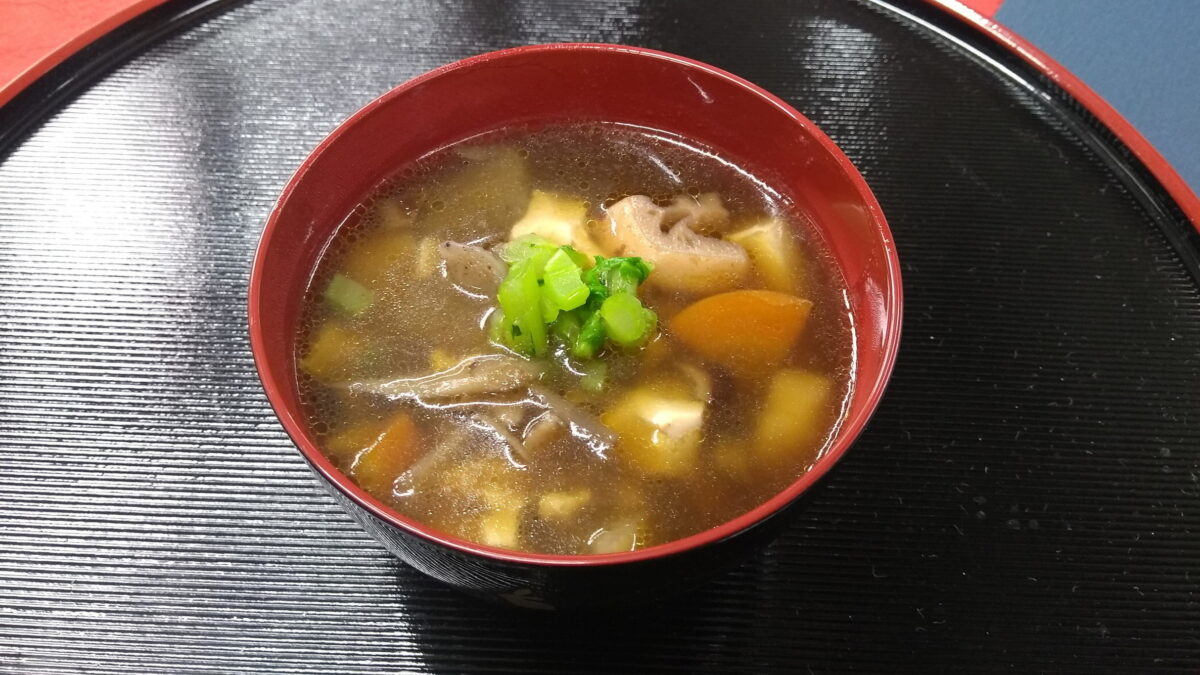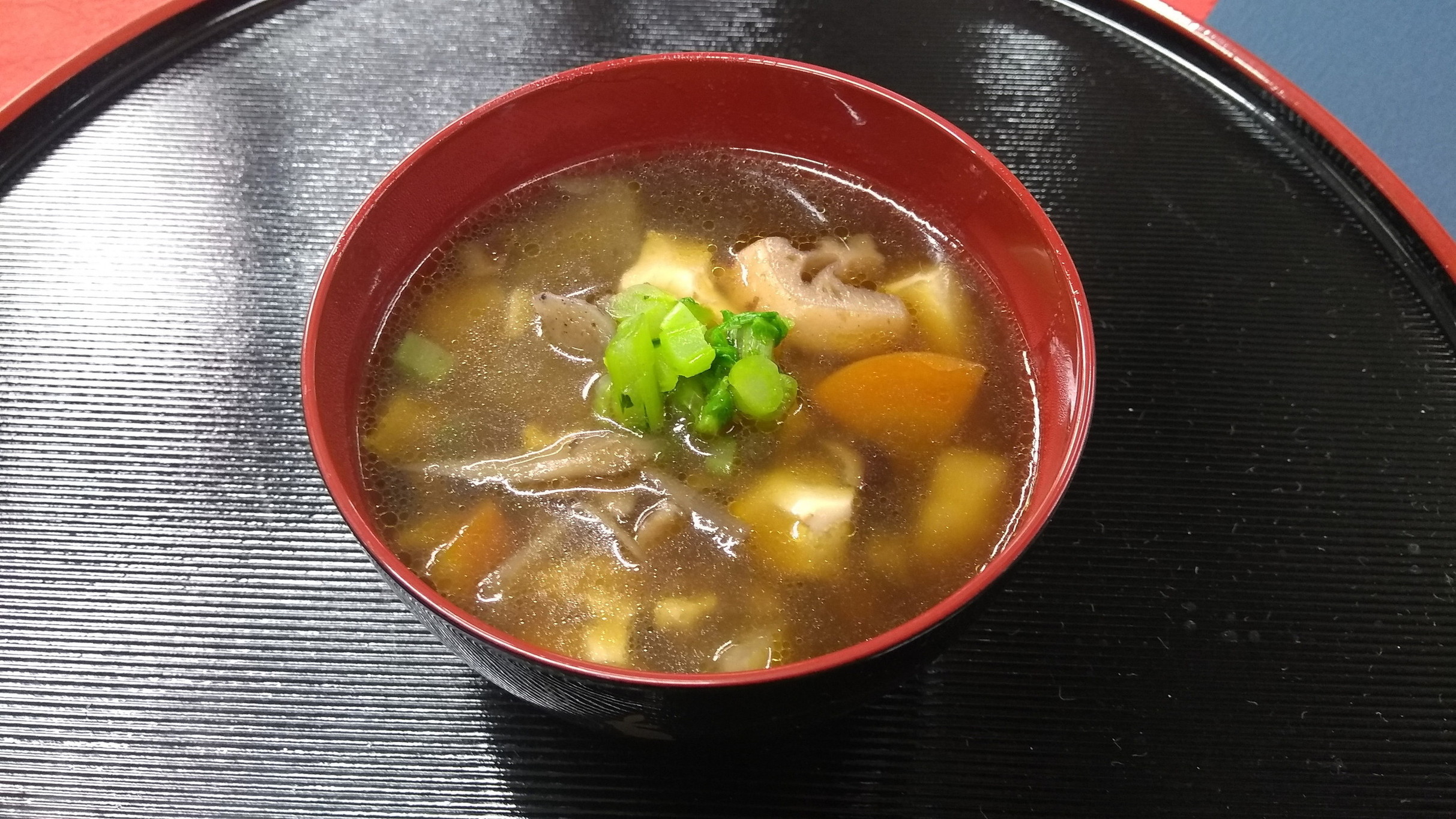
Alright, everyone, gather ’round for a taste of history and warmth! We’re diving into Kenchin-jiru, a hearty vegetable soup with deep roots in Kanagawa Prefecture. This isn’t just any soup; it’s a dish with a fascinating backstory and a whole lot of goodness. Let’s get to it!
Dish Name: Kenchin-jiru / けんちん汁
- Region / Location: Kamakura, and throughout Japan.
- Primary Area of Tradition: Kamakura, and now enjoyed nationwide.
- Main Ingredients: Konnyaku, burdock root, lotus root, carrot, daikon radish, taro, tofu, dried shiitake mushrooms, komatsuna (Japanese mustard spinach).
How It’s Eaten / Served
Kenchin-jiru is a vegetable-packed soup that’s enjoyed hot. The konnyaku and vegetables are cut into bite-sized pieces, stir-fried in sesame oil, and then simmered in a flavorful dashi broth. Once the vegetables are tender, it’s seasoned with salt and soy sauce, and the tofu is crumbled in. While the basic recipe is simple, there are countless variations depending on the family or region, with folks adding their own special touches.
Cultural Background and Preservation
Kenchin-jiru is a vegetable soup with a bit of a mystery surrounding its origins. There are a couple of popular theories: One suggests it comes from “Kenchan,” a type of “Kenchin” (巻繊) in Chinese Buddhist cuisine (Fucha ryori), while the other points to Kencho-ji Temple in Kamakura, where it’s said the soup was created and eventually became known as “Kenchin-jiru.” Regardless of which story is true, Kenchin-jiru has been enjoyed at Kencho-ji Temple for over 700 years, and it’s believed that monks from the temple spread the recipe throughout Japan as they traveled to different regions. Although it’s a Buddhist temple dish, it’s packed with various vegetables – and that’s because it was originally made from leftover vegetable scraps, a resourceful way to avoid food waste. Tofu is a key ingredient, and legend has it that the first head monk of Kencho-ji Temple added it to the soup after a clumsy monk dropped some, and he, of course, washed and put it in the soup!
Kenchin-jiru is enjoyed year-round, but it’s especially popular in the colder months because it uses root vegetables and is served hot. In some parts of the Kanto region, it’s also eaten during seasonal events like Setsubun (bean-throwing festival) or Ebisu-ko (a festival for good business).
Besides being a common dish in households, you can find Kenchin-jiru on the menu at many restaurants across Japan. Kencho-ji Temple has also shared its Kenchin-jiru with the public at events like the “Kencho-ji Temple Festival” in 2018 and 2019, where they served it from huge pots. It’s also served to participants in the bean-throwing ceremony at the temple’s annual Setsubun event in February. Furthermore, Kenchin-jiru is served about three times a year as a local dish in school lunches in Kamakura City.
Additional information:
- Fucha Ryori (普茶料理): A style of Japanese Buddhist cuisine with Chinese origins.
- Kencho-ji (建長寺): A famous Zen temple in Kamakura, Kanagawa Prefecture.
- Konnyaku (こんにゃく): A jelly-like food made from the konjac plant.
- Komatsuna (小松菜): Japanese mustard spinach.
- Dashi (だし): A Japanese soup stock, usually made from kombu (kelp) and shiitake mushrooms in the case of Kenchin-jiru.
- Setsubun (節分): The day before the beginning of spring in the old Japanese calendar, celebrated with rituals to drive away evil spirits.
- Ebisu-ko (恵比寿講): A festival held to pray for good business.
The information about regional cuisine featured on this website (Piggy's Grandma of Japan) is summarized and adapted from the Ministry of Agriculture, Forestry and Fisheries of Japan (MAFF) website, "Our Regional Cuisines"Additional commentary is provided based on the unique experiences and perspectives of the site's editors.
The copyright for the original content regarding regional cuisine belongs to the Ministry of Agriculture, Forestry and Fisheries of Japan.
The summaries and adaptations published on this site are intended for informational purposes only. Piggy's Grandma of Japan does not guarantee the accuracy or completeness of this information. For the most accurate and complete details, please refer to the original pages on the MAFF website.



